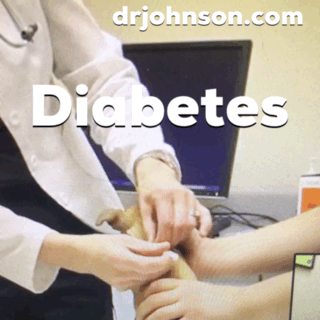Diabetes
Diabetes for Fractious Pet Owners
Diabetes mellitus (DM) is a disorder where the body is unable to regulate its blood sugar level.
Diabetes in pets is not a “Google” disorder and your vet needs to educate you. There is a ridiculous amount of “one size fits all” information out there. Online pharmacies will be happy to sell you insulin and needles without a prescription and Fosters and Smith have a Youtube Video on how to treat your cat for diabetes without the use of a Vet I think it says:
“Drs. Foster and Smith Pet Supplies
12.3K subscribers
Save time and money! Treat your dog at home with our diabetes supplies and this video guide. Shop Now: http://www.drsfostersmith.com/general…
That’s scary. That’s REALLY scary. But it’s not rare.
Diabetes II: Giving an Insulin Shot
Diabetes III: Giving an Insulin Shot to a Fractious Pet
Blood sugar levels are controlled, in part, by a replaceable hormone called insulin. Insulin is produced by the pancreas, a small organ located in the abdomen. Insulin is made by the pancreatic islet cells (also called the beta cells), then secreted into the blood, where it travels throughout the body and helps regulate blood sugar. Insulin also plays an important role in the body’s ability to use and store glucose.
Glucose must get inside the cell. Insulin allows glucose to pass from the blood into the cell.
The body’s cells use glucose as energy. Glucose circulates in the blood and is available to all the cells as a source of energy. In order to be used for energy, glucose must get inside the cell. Insulin allows glucose to pass from the blood into the cell. Insulin attaches to receptors on the cell, then glucose can enter the cell. Its like a key to a door. Insulin is the key, and it must attach to the cell before glucose can get through the door and into the cell.
Without insulin, glucose can not enter the cell. So the cell is “hungry” even though there are high levels of glucose in the blood. At this point, the body receives signals to start using fat and protein stores as energy sources. A diabetic animal often eats extra food because it is trying to supply its body with additional energy. But the food is not used efficiently, so even though the animal is eating a lot, the pet is still losing weight.
The body eliminates excess blood glucose by filtering it through the kidneys and passing it into the urine. Water must be used to flush excess glucose out of the body. This is why you see excessive urine volume in a diabetic. Because so much water is being used to flush the excess glucose out of the body, the animal is thirsty and drinks a lot.
So the lack of insulin sets up a complicated series of events that result in the signs you observe in a diabetic animal. Polyuria (excessive urination), polydipsya (excessive water consumption), polyphagia (excessive eating), and weight loss.
Types of Diabetes
Type I: Decreased insulin production by the pancreatic bets cells. Type I diabetes is always insulin dependent (IDDM)
Type II: Decreased responsiveness of the body’s cells to insulin, or, improperly functioning beta cells.
Type II diabetes may be either insulin dependent (IDDM) or non-insulin dependent (NIDDM)
Transient DM: When the insulin requirement comes and goes. Approximately 20 percent of diabetic cats may experience periods where they no longer require insulin injections. These periods may range from weeks to months. The diabetes may recur and insulin must be given again.
IDDM and NIDDM are seen in both dogs and cats. Most dogs have IDDM.
Signs
The classic signs of diabetes are
- polyuria (PU) – excessive urination
- polydipsia (PD) – excessive thirst
- Polyphagia – excessive appetite or eating
- weight loss
- lethargy
- As the disease progresses, the signs include anorexia (loss of appetite), depression, and vomiting.
Dogs are often diagnosed with diabetes because the owner may notice that the dog has suddenly gone blind. This is due to the rapid cataract development that results from diabetes in dogs.
Cats are often diagnosed with diabetes because the owner notices the cat has weak rear legs or it is walking on its hocks. The weak hind legs is called diabetic neuropathy, and walking on the hocks is called plantigrade posture.
Prevalence
DM occurs in about one of every 400-500 dogs and cats.
AGE – Most cats are over 6 years old. 75% are between 8-13.
Most dogs are between 7-9 years old.
Although less common, DM has been seen in very young cats and dogs.
GENDER – neutered male cats and unspayed female dogs are more prone to diabetes
BREED – there is no breed predisposition in cats.
Keeshond, puli, miniature pinscher, cairn terrier have a genetic predisposition to DM
poodle, dachshund, miniature schnauzer, and beagle breeds are possibly at higher risk.
Risk Factors
OBESITY – both obese cats and dogs are at risk for developing type II diabetes. Cats over 15 pounds are at high risk.
DIESTRUS in the unspayed female dog (bitch). The period of sexual inactivity after the female is receptive.
Causes
- genetic
- infectious viral diseases
- immune-mediated destruction of the pancreatic beta cells
- pancreatitis
- predisposing diseases: hyperadrenocorticism, acromegaly
- drugs: glucocorticoids (steroids) and progestagens (reproductive hormones)
Diagnosis
A diagnosis of DM is made based on clinical signs, physical exam, and lab tests.
Findings typically include persistent hyperglycemia (elevated blood sugar) and glucosuria (glucose in the urine). Often, ketones are present in the urine or blood.
Normal blood glucose values range from about 80-120 mg/dL. Diabetic animals can have blood glucose values that are moderately elevated, or extremely elevated (600+ mg/dL).
A diagnosis of DM can not be based on a single elevated blood glucose measurement, particularly in cats. This is because cats frequently experience stress-induced hyperglycemia, where the blood glucose can be in the 300-400 mg/dL range just because of stress. However, stress-induced hyperglycemia does not usually result in glucosuria (elevated urine glucose).





